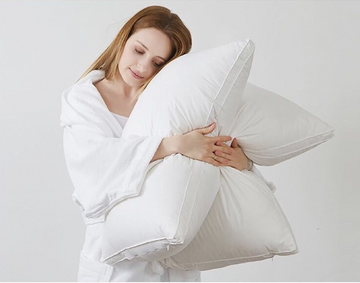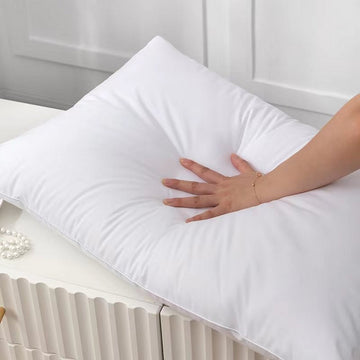The Essentials of Pillow Comfort: Materials, Design, and Features
Understanding the Materials: Natural vs. Synthetic
When it comes to choosing a pillow, materials matter. Broadly, they fall into two camps: natural and synthetic. Natural options like down, feather, wool, and latex tend to be breathable and long-lasting. Synthetic fibers, such as polyester and memory foam, offer allergy relief and easy care. Each has pros and cons regarding comfort, support, durability, and upkeep. It's about finding the balance that suits your need for a great night's sleep.

Design Elements for Maximum Comfort
When choosing pillows, design elements play a crucial role in ensuring comfort. Key elements to consider include the pillow's shape and size, which should match your sleeping position for optimal support. Ergonomically designed pillows can enhance neck alignment and reduce strain. Additionally, gussets or sidewalls can provide enhanced support and maintain the pillow's shape over time. Breathability is also important; look for designs with ventilation features that help regulate temperature and maintain airflow, promoting a cooler and more restful night's sleep.
Key Features to Look for in Pillows
When exploring pillows, focus on specific features. Look for ones that adapt to your sleep posture. They should support your neck and spine. Prefer pillows with removable covers for easy cleaning. Hypoallergenic fills are a must for allergy sufferers. A breathable fabric keeps you cool at night. Silent materials are key for light sleepers. Lastly, check the pillow's durability and warranty. These factors ensure a restful sleep and pillow longevity.
The Art of Duvet Selection: Weaving Quality with Thread Count and Fabric Types
Decoding Thread Count: The Importance of Material and Weave
Thread count refers to the number of threads woven into one square inch of fabric, and is a commonly referenced indicator while choosing bedding, especially duvets. However, it's crucial to understand that higher thread count doesn't always equate to higher quality. The quality of the threads themselves and the type of weave also play significant roles in the overall comfort and durability of the duvet. For instance, a 300-thread-count duvet with high-quality cotton threads and a sateen weave can feel more luxurious and last longer than a 600-thread-count duvet with lower quality fibers and a basic weave. Thus, when selecting a duvet, consider both the thread count and the quality of material and weave together to achieve the balance of comfort and durability.
The Best Fabrics for Duvets: Feather, Down, and Synthetic Blends
When selecting a duvet, the fabric is key. There are three top choices: feather, down, and synthetic. Feather duvets are sturdy and warm, often with a quilted design. They can be heavy. Down duvets are light and fluffy, providing excellent warmth. They are known for luxury. Synthetic blends, like microfiber, are hypoallergenic. They suit those with allergies. Each fabric has its merits depending on personal preference and needs.
Tips for Choosing the Right Duvet for Your Climate
Selecting the right duvet for your climate is crucial. Here are tips for the best choice:
- Warm Climates: Opt for lightweight duvets with low to medium fill power. Natural breathable materials like cotton are ideal.
- Cold Climates: Choose a high-fill-power duvet. Materials such as wool or down provide excellent insulation.
- Temperate Climates: A medium weight duvet works well. Look for one that can be layered or opened as needed.
- Allergy Considerations: Hypoallergenic materials suit all climates and are great for sensitive sleepers.
- Moisture Control: For humid areas, select moisture-wicking fabrics to stay dry and comfortable.
Prioritize your comfort by matching the duvet to your local weather patterns.
Pillowcases and Bonnets: Enhancing Your Sleep Environment
The Role of Pillowcases in Achieving Perfect Sleep
Pillowcases are more than just a cover for your pillow. They touch your skin all night. So, the right fabric can help you sleep better. It can keep you cool or warm. It can also prevent allergy flare-ups. Choose soft, breathable materials like cotton or silk. They feel good and help keep your skin healthy. Pillowcases come in many types. Some wick away moisture. Others repel dust mites. For beauty sleep, silk pillowcases reduce hair frizz and face creases. Remember, your choice of pillowcase can enhance your sleep quality every night.
Material Choices for Pillowcases and Bonnets
When selecting materials for pillowcases and bonnets, comfort and functionality go hand-in-hand. Cotton stands out for its breathability and softness, making it a popular choice for all-season comfort. Silk, known for its smooth texture, helps in reducing friction on hair and skin, thus minimizing damage during sleep. For warmth in colder seasons, flannel is favored for its insulating properties. On the other hand, microfiber is preferred for its durability and resistance to wrinkles. Each material offers unique benefits, so consider your personal comfort needs and skin sensitivities when choosing.
Seasonal Considerations in Pillowcase Selection
When picking pillowcases, think about the season. In hot months, light cotton or silk keeps you cool. For cold weather, flannel or jersey is cozy. A blend, like cotton-polyester, works all year. This fabric dries fast and is easy to clean. Always have two sets per season for freshness. Your sleep will thank you!






